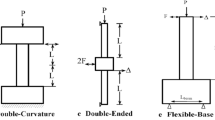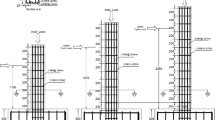Abstract
Many concrete structures have been damaged during recent earthquakes due to the low ductility of their columns. Hence, several recent research contributions have been dedicated to producing high-performance concrete materials. Among these contributions, carbon nanotubes (CNTs) are of superior mechanical properties and can be used as additive in concrete. In this research, a sequential multiscale method, including nano-, micro-, meso- and macro-scales, is used to investigate the cyclic and seismic responses of concrete columns through numerical simulations. The aim of this research is to investigate the load-carrying capacity and energy absorption of CNT-reinforced concrete columns under cyclic loading. The results of the current research indicate that both of these properties improve significantly in the presence of CNTs. Furthermore, the results of fragility analysis reveal that for similar damage states, a CNT-reinforced column reaches the specified damage state at higher peak ground motion acceleration than an ordinary concrete column. Hence, the use CNTs in concrete structures may prove beneficial for high-seismic risk areas.




















Similar content being viewed by others
References
Kawashima K et al (2007) Failure mechanism of column components and systems of bridges. In: Structural engineering research frontiers. https://doi.org/10.1061/40944(249)36
Zhang J, Huo Y (2009) Evaluating effectiveness and optimum design of isolation devices for highway bridges using the fragility function method. Eng Struct 31(8):1648–1660
Shin M et al (2013) Effectiveness of low-cost fiber-reinforced cement composites in hollow columns under cyclic loading. Constr Build Mater 47:623–635
Cho C-G et al (2012) Cyclic responses of reinforced concrete composite columns strengthened in the plastic hinge region by HPFRC mortar. Compos Struct 94(7):2246–2253
Ganesan N, Indira P, Sabeena M (2014) Behaviour of hybrid fibre reinforced concrete beam–column joints under reverse cyclic loads. Mater Des 54:686–693
Laurent D, Ahmed L (2002) Behavior of high-strength fiber-reinforced concrete beams under cyclic loading. Struct J 99(3):248–256
Harajli MH, Gharzeddine O (2007) Effect of steel fibers on bond performance of steel bars in NSC and HSC under load reversals. J Mater Civ Eng 19(10):864–873
Campione G, Letizia Mangiavillano M (2008) Fibrous reinforced concrete beams in flexure: experimental investigation, analytical modelling and design considerations. Eng Struct 30(11):2970–2980
Lequesne R et al (2010) Seismic detailing and behavior of coupling beams with high-performance fiber reinforced concrete. In: Symposium–four decades of progress in prestressed concrete, fiber reinforced concrete, and thin laminate composites, SP-272
Hung C-C, Su Y-F, Yu K-H (2013) Modeling the shear hysteretic response for high performance fiber reinforced cementitious composites. Constr Build Mater 41:37–48
Iijima S (1991) Helical microtubules of graphitic carbon. Nature 354(6348):56–58
Eftekhari M, Mohammadi S (2016) Molecular dynamics simulation of the nonlinear behavior of the CNT-reinforced calcium silicate hydrate (C–S–H) composite. Compos A Appl Sci Manuf 82:78–87
Nielson BG, DesRoches R (2007) Seismic fragility methodology for highway bridges using a component level approach. Earthq Eng Struct Dyn 36(6):823–839
Siqueira GH et al (2014) Performance evaluation of natural rubber seismic isolators as a retrofit measure for typical multi-span concrete bridges in eastern Canada. Eng Struct 74:300–310
Eftekhari M, Mohammadi S, Khoei AR (2013) Effect of defects on the local shell buckling and post-buckling behavior of single and multi-walled carbon nanotubes. Comput Mater Sci 79:736–744
Eftekhari M, Hatefi Ardakani S, Mohammadi S (2014) An XFEM multiscale approach for fracture analysis of carbon nanotube reinforced concrete. Theor Appl Fract Mech 72:64–75
Šmilauer V, Hlaváček P, Padevět P (2012) Micromechanical analysis of cement paste with carbon nanotubes. Acta Polytechnica 52(6):22–28
Eftekhari M, Mohammadi S (2016) Multiscale dynamic fracture behavior of the carbon nanotube reinforced concrete under impact loading. Int J Impact Eng 87:55–64
Eftekhari M et al (2018) Multi-scale modeling approach to predict the nonlinear behavior of CNT-reinforced concrete columns subjected to service loading. Structures 14:301–312
Du X, Jin L, Ma G (2014) Numerical simulation of dynamic tensile-failure of concrete at meso-scale. Int J Impact Eng 66:5–17
Kim S-M, Abu Al-Rub RK (2011) Meso-scale computational modeling of the plastic-damage response of cementitious composites. Cem Concr Res 41(3):339–358
Nguyen VP, Stroeven M, Sluys LJ (2012) Multiscale failure modeling of concrete: micromechanical modeling, discontinuous homogenization and parallel computations. Comput Methods Appl Mech Eng 201–204:139–156
Qian Z (2012) Multiscale modeling of fracture processes in cementitious materials. Ph.D. thesis, Delft University of Technology
Mazzoni S et al (2006) OpenSees command language manual. Pacific Earthquake Engineering Research (PEER) Center, Berkeley
Scott BD, Park R, Priestley MJN (1982) Stress-strain behavior of concrete confined by overlapping hoops at low and high strain rates. J Proc 79(1):13–27
Zhang Y-Y, Harries KA, Yuan W-C (2013) Experimental and numerical investigation of the seismic performance of hollow rectangular bridge piers constructed with and without steel fiber reinforced concrete. Eng Struct 48:255–265
Mander J, Priestley M, Park R (1988) Observed stress-strain behavior of confined concrete. J Struct Eng 114(8):1827–1849
Menegotto M, Pinto PE (1973) Method of analysis for cyclically loaded RC plane frames including changes in geometry and non-elastic behavior of elements under combined normal force and bending. In: Symposium on resistance and ultimate deformability of structures acted on by well defined repeated loads, Lisboa
Wang Z, Dueñas-Osorio L, Padgett JE (2014) Influence of scour effects on the seismic response of reinforced concrete bridges. Eng Struct 76:202–214
Bosco M et al (2016) Improvement of the model proposed by Menegotto and Pinto for steel. Eng Struct 124:442–456
Saatcioglu M, Ozcebe G (1989) Response of reinforced concrete columns to simulated seismic loading. ACI Struct J 86(1):3–12
Monti G, Spacone E (2000) Reinforced concrete fiber beam element with bond-slip. J Struct Eng 126(6):654–661
Spacone E, Filippou FC, Taucer FF (1996) Fibre beam–column model for non-linear analysis of R/C frames: part I. Formulation. Earthq Eng Struct Dyn 25(7):711–725
Zhao J, Sritharan S (2007) Modeling of strain penetration effects in fiber-based analysis of reinforced concrete structures concrete structures. ACI Struct J 104(2):133–141
Rush D et al (2014) Towards fragility analysis for concrete buildings in fire: residual capacity of concrete columns. In: 8th international conference on structures in fire
Deepu SP, Prajapat K, Ray-Chaudhuri S (2014) Seismic vulnerability of skew bridges under bi-directional ground motions. Eng Struct 71:150–160
Ramanathan K, DesRoches R, Padgett JE (2012) A comparison of pre- and post-seismic design considerations in moderate seismic zones through the fragility assessment of multispan bridge classes. Eng Struct 45:559–573
Cornell C et al (2002) Probabilistic basis for 2000 SAC federal emergency management agency steel moment frame guidelines. J Struct Eng 128(4):526–533
Ghafory-Ashtiany M, Mousavi M, Azarbakht A (2011) Strong ground motion record selection for the reliable prediction of the mean seismic collapse capacity of a structure group. Earthq Eng Struct Dyn 40(6):691–708
Choi E et al (2013) Seismic fragility analysis of lap-spliced reinforced concrete columns retrofitted by SMA wire jackets. Smart Mater Struct 22(8):085028
Shinozuka M et al (2002) Fragility curves of concrete bridges retrofitted by column jacketing. Earthq Eng Eng Vib 1(2):195–205
Choi E, DesRoches R, Nielson B (2004) Seismic fragility of typical bridges in moderate seismic zones. Eng Struct 26(2):187–199
Karrech A, Abbassi F, Basarir H, Attar M (2017) Self-consistent fractal damage of natural geo-materials in finite strain. Mech Mater 104:107–120
Karrech A, Schrank C, Freij-Ayoub R, Regenauer-Lieb K (2014) A multi-scaling approach to predict hydraulic damage of poromaterials. Int J Mech Sci 78:1–7
Gaede O, Regenauer-Lieb K, Karrech A (2013) Anisotropic damage mechanics as a novel approach to improve pre and post-failure borehole stability analysis. Geophys J Int 193(3):1095–1109
Author information
Authors and Affiliations
Corresponding author
Rights and permissions
About this article
Cite this article
Eftekhari, M., Karrech, A. & Elchalakani, M. Investigation into the Nonlinear Time-History Analysis of CNT-Reinforced Concrete Column by a Multiscale Approach. Int J Civ Eng 18, 49–64 (2020). https://doi.org/10.1007/s40999-019-00459-6
Received:
Revised:
Accepted:
Published:
Issue Date:
DOI: https://doi.org/10.1007/s40999-019-00459-6




